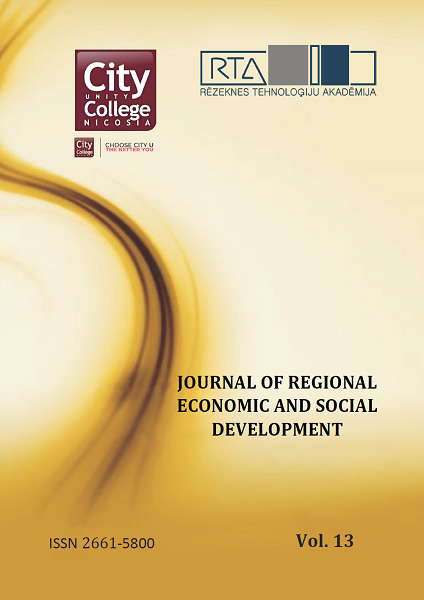TRENDS OF CONSUMER PURCHASES VIA SOCIAL MEDIA ACCORDING TO THE STIMULUS-ORGANISM-RESPONSE (SOR) MODEL
DOI:
https://doi.org/10.17770/jresd2021vol1.13.6712Keywords:
Company, Entrepreneurship, Management, Organism, Response, Social media, StimulusAbstract
The theme of this paper is ,,Trends of Consumer Purchases via Social Media according to the Stimulus-Organism-Response (SOR) Model’’. Social media are an important platform for entrepreneurship development, and a lot of entrepreneurs are using social media for marketing and selling activities in order to increase sales and attract potential customers. The topicality of the research is based on economic development requirements. The aim of the research – to identify the situation and to develop proposals for entrepreneurs and managers in Latvia. The tasks of the research are the following: to develop a survey, to carry out theoretical research; to develop proposals. The research period was from March until June 2021. General scientific research methods were used in the research: the monographic and descriptive methods, the survey method, the comparative analysis method for studying the concept of SOR at social networking and future development possibilities. The survey conducted in the study showed the tendencies of Latvian consumers' purchases via social media. The study hypothesis confirmed that according to the Stimulus-OrganismResponse Model, advertising, opinion leaders, and user-generated content act as the stimulus (S) to evoke positive emotions (O), which later leads to impulse purchases (R) for consumers.
Downloads
References
Abd-Alrazaq et al. (2020) Top concerns of Tweeters during the COVID-19 pandemic: infoveillance study Retrieved from: https://www.jmir.org/2020/4/e19016/
Anuja, A., Shivam, B., Chandrashekhar, K., Reema, A., Yogesh, D. (2019) Journal of Retailing and Consumer Services. Volume 49, July 2019, Pages 86-101. Retrieved from: https://www.sciencedirect.com/science/article/abs/pii/S0969698919300128
Attiq et al. (2017) The impact of supportive work environment, trust, and self-efficacy on organizational learning and its effectiveness: a stimulus-organism response approachBus. Econ. Rev., 9 (2) (2017), pp. 73-100
Bagozzi. (1986) Principles of marketing management. R.P. Bagozzi (1st ed.), Science Research Associates (1986).
Borgatti, S. P., & Halgin, D. S. (2011) On Network Theory. Organization Science, 22, (5), 1168–1181.
Donovan R., Rossiter J. (1982) Store atmosphere: An environmental psychology approach, Journal of Retailing, 58 (1) (1982), pp. 34-57.
Eroglu, S.A., Machleit .K.A., and Davis L.M. (2001) Atmospheric qualities of online retailing. Journal of Business Research, 54 (2) (2001), pp. 177-184, 10.1016/S0148-2963(99)00087-9
Farooq et al. (2020) Impact of online information on self-isolation intention during the COVID-19 pandemic: cross-sectional study. Retrieved from: https://www.jmir.org/2020/5/e19128/
Fu et al. (2020) Exploring an adverse impact of smartphone overuse on academic performance via health issues: A stimulus-organism-response perspective. Behaviour & Information Technology (2020), pp. 1-13, 10.1080/0144929X.2020.1716848
Gcfglobal.org. (2021) What is Facebook? Retrieved from: https://edu.gcfglobal.org/en/facebook101/what-is-facebook/1/
GolinRiga. (2021) Influencer. Retrieved from: http://www.influenceri.lv/mikro-influenceri/
Jacoby, J. (2002) Stimulus-organism-response reconsidered: An evolutionary step in modeling (consumer) behavior. Journal of Consumer Psychology, 12 (1) (2002), pp. 51-57, 10.1207/S15327663JCP1201_05
Kemp, S. (2020) Digital in 2020: New decade, new milestones. Retrieved from: https://wearesocial.com/digital-2020
Kristapsone, S. (2008) Scientific research in the study process. Riga: School of Business Administration Turiba, 2008. 352 lpp.
Laato, S., Islam, A.K.M.N., Farooq, A., Dhir, A. (2020) Unusual purchasing behavior during the early stages of the COVID-19 pandemic: The stimulus-organism-response approach. Journal of Retailing and Consumer Services Volume 57, November 2020, 102224. Retrieved from: https://www.sciencedirect.com/science/article/pii/S0969698920304598?dgcid=raven_sd_recommender_email
Mehrabian A. Russell, J.A. (1974) An Approach to Environmental Psychology the MIT Press.
Newberry., C. (2021) 44 Instagram Stats That Matter to Marketers in 2021. Retrieved from: https://blog.hootsuite.com/instagram-statistics/#Instagram_business_statistics
Pandita, S., Mishra, H.G., Chib, S. (2021) Psychological impact of covid-19 crises on students through the lens of Stimulus-Organism-Response (SOR) model. Retrieved from: https://www.sciencedirect.com/science/article/pii/S0190740920322052
Pavlov, I.P. (1927) Conditioned reflexes: An investigation of the physiological activity of the cerebral cortex” Translated by GV Anrep (1st ed.), Oxford University Press.
Pekkala, K., van Zoonen, W. (2021) Work-related social media use: The mediating role of social media communication self-efficacy. European Management Journal. Available online 16 March 2021.
Retrieved from: https://www.sciencedirect.com/science/article/pii/S0263237321000499
Peng, C. and Kim, Y.G. (2014) Application of the stimuli-organism-response (S-O-R) framework to online shopping behavior. Journal of Internet Commerce, 13 (3–4) (2014), pp. 159-176, 10.1080/15332861.2014.944437
Skinner, B.F. (1935) The Generic Nature of the Concepts of Stimulus and Response. The Journal of General Psychology, 12 (1) (1935), pp. 40-65, 10.1080/00221309.1935.9920087 Retrieved from:
https://www.tandfonline.com/doi/abs/10.1080/00221309.1935.9920087
Spence, K.W. (1950) Cognitive versus stimulus-response theories of learning
Psychological Review, 57 (3) (1950), pp. 159-172, 10.1037/h0058250
Statista.com. (2021) Influencer marketing market size worldwide from 2016 to 2021. Retrieved from: https://www.statista.com/statistics/1092819/global-influencer-market-size/#statisticContainer
Stone, T. (2018) Social Network Theory — a literature review for understanding innovation programs. Retrieved from: https://medium.com/swlh/social-network-theory-a-literature-review-for-understanding-innovation-programs-7f1c214e9a77
Topmedia.lv. Influencers and marketing. Retrieved from:https://www.topmedia.lv/post/influenceri-un-m%C4%81rketings
Webwise.ie. Explained: What is Instagram? Retrieved from:
https://www.webwise.ie/parents/explained-image-sharing-app-instagram/
Wolfe, J., (2018) Advertisers Love Influencer Marketing: ANA Study.Retrieved from: https://www.ana.net/content/show/id/48437
Woodworth, (1929) Psychology (revised edition) R. Woodworth (2nd ed.), Henry Holt (1929)
Young, G. (2016) Stimulus–organism–response model: SORing to new heights. Unifying causality and psychology, Springer International Publishing (2016), pp. 699-717, 10.1007/978-3-319-24094-7_28


